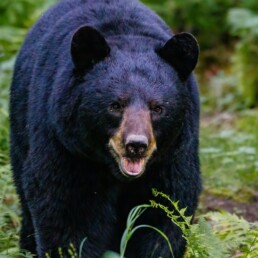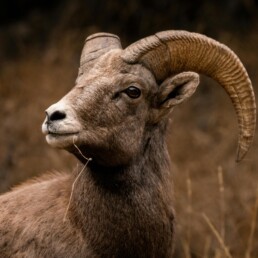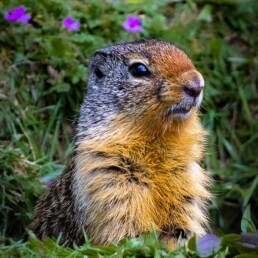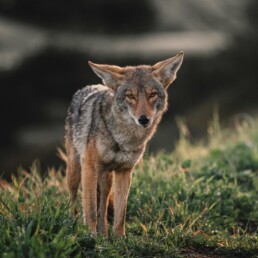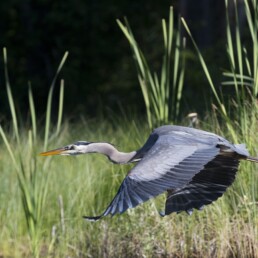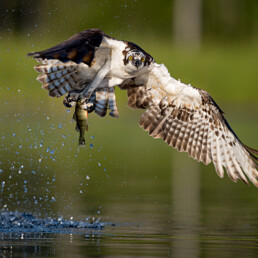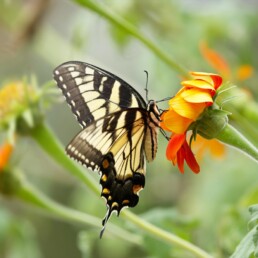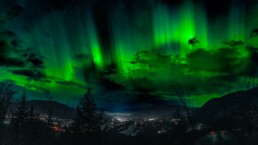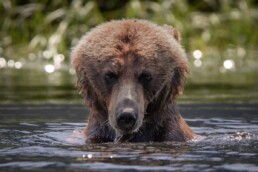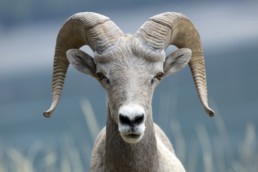Located in a lush valley at the confluence of two major rivers, Castlegar is rich in wildlife habitat that provides ample opportunity to spot animals in their natural environment.
There are large terrestrial fauna such as elk, bears, and mountain goats but also smaller, yet equally fascinating creatures to spy such as the Columbia ground squirrel, Red Fox, and Western Tiger Swallowtail butterfly. In the waters are Kokanee salmon and White Sturgeon, which can grow as long as 10 feet, and in the air local birders have documented over 250 different species of birds from Osprey and Bald Eagles to Blue Heron and Rufous hummingbirds.
The best times to see animals are usually early in the morning or in the evening before nightfall when they’re most active. Pick spots near water or forest clearings and be patient, quiet and still. The goal of wildlife viewing is to safely appreciate the animals in their natural surroundings with minimal impact. To achieve that, here are eight tips:
- Be respectful. Getting too close or staying too long can disrupt feeding and other important behaviours and can cause stress and unpredictable behaviour.
- Give wildlife lots of space. If an animal responds to your presence (eg: looks up, watches you, moves away), you are too close.
- Viewing roadside wildlife can have negative impacts on wildlife by disrupting feeding and leading to habituation to traffic and people. If you spot wildlife while driving, pull over only if it is safe to do so and keep your stop short and sweet.
- Keep dogs on leash and under control at all times to avoid negative encounters
- Carry bear spray and know how to use it.
- Use binoculars and zoom lenses.
- Never feed wildlife.
- Leave no trace. Pack it in, pack it out.
American Black Bear
Black bears are one of the most common wildlife species seen in the Castlegar area. The lush valley bottoms provide ideal black bear habitat and ample food sources. While dangerous encounters with bears are rare, conflict is common when bears are allowed to access unnatural foods such as garbage and birdseed. Black bears tend to use riparian and forested corridors to move through town, but they can be encountered all over town, especially in the late summer and fall.
Bighorn Sheep
Bighorn sheep are an easily recognizable ungulate with iconic curved horns. A social animal, bighorn sheep spend most of the year in small herds with the rams in separate “bachelor groups.” Castlegar is actually outside of this species’ historic range, but a successful introduction program in the 1980s saw a herd established near Syringa Provincial Park.
Coyote
Coyotes are an intelligent, social canine known for their adaptability. They are one of the few animals whose range has expanded since European settlement, moving from their historic range in the prairie provinces into BC and much of the rest of Canada. Coyotes can often be heard yipping and howling at night around Castlegar but tend to stay out of sight during the daylight hours.
Great Blue Heron
Great Blue Herons are an impressive bird, standing over a metre tall with a wingspan reaching up to two metres across. A wading bird, Great Blue Herons spend much of their time standing motionless in shallow water, waiting for prey to swim by. Herons can be seen along the shores of the Columbia River year-round and are fascinating to watch as they fish in the shallows. Photo by Monte Comeau.
Osprey
Osprey are large raptors known for their impressive fishing skill. Once they arrive in the Castlegar area in April or May, they can usually be found flying above their favoured fishing grounds along the Kootenay and Columbia Rivers. Watching an osprey hunt for fish is an incredible wildlife viewing experience. Photo by Monte Comeau.
Western Tiger Swallowtail
Perhaps the most common butterfly in the Castlegar area, the Western Tiger Swallowtail is a large, brightly coloured butterfly that favours open, sunny habitat. This beautiful butterfly can be seen all over Castlegar and the surrounding area through the summer months, especially in June and July.
White Sturgeon
Sturgeon have existed, relatively unchanged, for millions of years. These prehistoric giants are the largest freshwater fish in Canada and they live for upwards of 100 years. The Columbia River population is endangered due to historic overfishing and the construction of dams that altered the river’s natural flow rates and impacted the species’ spawning success. Despite this, you can still spot these giants in the shallows of the Columbia River around Castlegar, especially during the late Spring.
There are many areas in and around Castlegar that are excellent for wildlife viewing. Here is a list of some of the best:
-
- Waldie Island: Walk along this riverside trail to find Great Blue Heron, songbirds, waterfowl and signs of beaver activity.
- Millennium Walkway: There are many great benches along the river to watch waterfowl, Osprey, and Bald Eagles. Keep an eye out for black bears in the park and sturgeon in the shallows along the riverbank.
- Syringa Provincial Park: This beautiful park is home to bighorn sheep, Osprey, Bald Eagle, black bear and more. Check out the newly planted butterfly garden to learn about local pollinators, too!
- Selkirk College: This huge network of trails provides ample opportunity to spot songbirds, birds of prey, coyote, elk, and bear.
- Dove Hill: This hike to a beautiful viewpoint takes you through excellent songbird habitat that is alive with song in the spring. It’s also a great spot to look for birds of prey and the occasional black bear.
- Mt. Sentinel: From the Millenium walkway, scan the mountainside with binoculars to spot elk and bear.
- Pass Creek Regional Park: This is a great place to see kokanee salmon spawning in September- October.
- Bombi Pass, Strawberry Pass and Paulson Pass: Take an early morning or evening drive up any of these scenic mountain passes to spot grizzly, black bears and other wildlife.
- Mel Deanna Trail: This hike loops around Champion Ponds and it's easy to spot plenty of forest species from chipmunks to flycatchers as well as waterfowl such as the Barrow’s Goldeneye, which has its breeding grounds in this area.
Meet Musician and Photographer Yanive Feiner
April 2, 2024
Yanive Feiner is a musician, photographer, teacher, and a big fan of Castlegar. Find out what inspires him as an artist in this interview.
0 Comments10 Minutes
Meet Castlegar Photographer Josh Fogal
March 15, 2024
Meet Josh Fogal. He's only been doing photography for 3 years but he already has his work hanging in the Kootenay Gallery.
0 Comments4 Minutes
Stefanie Harron Shares Her Wildlife Photography Secrets
May 30, 2022
Stefanie Harron is a Castlegar-based photographer who specializes in capturing landscape, wildlife and astral images.
0 Comments5 Minutes


